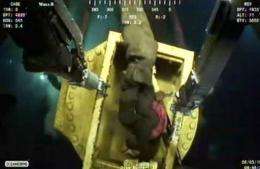BP cuts off broken oil pipe with giant shears

BP on Thursday successfully cut off a fractured oil pipe using giant shears, pressing ahead with its latest bid to seal the Gulf of Mexico leak as President Barack Obama announced a third trip to the region.
After a diamond-blade saw got stuck in the pipe lying a mile down on the sea bed, the British energy giant was forced to use rougher means to get the job done.
"The other saw that we attempted to use was not successful in getting the internal drill pipe so we replaced it with the shears, which don't have as clean a cut, but we do have a cut now," Admiral Thad Allen told reporters.
Allen, who is overseeing the US government's response to the six-week spill, hailed the cutting of the pipe as a "significant step forward."
The next step is to place a containment cap securely over the cut and trap the spewing oil so it can be siphoned off, he said.
BP has battled unsuccessfully to cap or contain the disastrous leak, now the worst in US history, since an April 20 explosion tore through a BP-leased rig just off the Louisiana coast.
The company's chief executive Tony Hayward acknowledged in an interview with the Financial Times published Wednesday that the firm was unprepared for the disaster and "did not have the tools you would want in your tool-kit."
Workers are using robotic submarines working in cold waters a mile down (1,600 meters) on the sea bed to stem the flow of oil, which was closing in on Florida beaches Thursday after fishing was banned in new areas.
Allen said a "top hat" containment device would be lowered now that the pipe was shorn off.
"We'll have to see as we put the containment cap on exactly how effective it is," he told journalists.
The US government has estimated the flow of oil before the riser was cut away at 12,000 to 19,000 barrels a day -- meaning at least 20 million gallons have already poured into the Gulf.
But BP's chief operating officer Doug Suttles has acknowledged that until the cap is in place the oil flow would likely increase by as much as 20 percent.
Allen also said that nearly one million gallons of dispersants have been used to break up oil in the Gulf of Mexico spill.
"We're approaching the million gallon mark and it's a milestone and there are concerns about that and we will continue to work the dispersants very, very closely."
Many environmentalists have voiced concern over the unprecedented use of so much dispersant, warning its long-term effect on marine and wildlife is unknown.
Allen stressed BP's operation to drill two relief wells -- seen as the only way to permanently cap the failed wellhead -- was on target to be completed in mid-August.
Amid rising political fallout from the disaster, the White House said Obama would make a third trip to the region on Friday to survey efforts to combat and clean up the spill.
BP, whose stock plunged in value this week, was downgraded Thursday by ratings agency Fitch from "AA+" to "AA" because of the risks from the oil spill, which has cost the company a billion dollars so far.
In Florida, residents were bracing for the arrival of the slick after the National Oceanic and Atmospheric Administration (NOAA) said the spill was some seven miles (11 kilometers) off the state's shores.
Florida would be the fourth state hit by the oil since the explosion ripped through the Deepwater Horizon rig killing 11 workers.
More than 125 miles (200 kilometers) of Louisiana coast have been contaminated, triggering long-term fears for the region's already vulnerable and endangered wildlife.
A University of Miami study showed the oil slick's surface area now stretches across 9,435 square miles (24,435 square kilometers) of the Gulf -- triple the size of satellite imagery from May 1.
Experts also warn the majority of the oil is contained in vast underwater plumes that cannot be measured from above.
US officials have closed more than a third of Gulf of Mexico waters, extending a fishing ban to 88,502 square miles (229,219 square kilometers) -- about 37 percent of the Gulf's federal waters.
(c) 2010 AFP



















